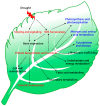Drought-Responsive Mechanisms in Plant Leaves Revealed by Proteomics
- PMID: 27763546
- PMCID: PMC5085738
- DOI: 10.3390/ijms17101706
Drought-Responsive Mechanisms in Plant Leaves Revealed by Proteomics
Abstract
Plant drought tolerance is a complex trait that requires a global view to understand its underlying mechanism. The proteomic aspects of plant drought response have been extensively investigated in model plants, crops and wood plants. In this review, we summarize recent proteomic studies on drought response in leaves to reveal the common and specialized drought-responsive mechanisms in different plants. Although drought-responsive proteins exhibit various patterns depending on plant species, genotypes and stress intensity, proteomic analyses show that dominant changes occurred in sensing and signal transduction, reactive oxygen species scavenging, osmotic regulation, gene expression, protein synthesis/turnover, cell structure modulation, as well as carbohydrate and energy metabolism. In combination with physiological and molecular results, proteomic studies in leaves have helped to discover some potential proteins and/or metabolic pathways for drought tolerance. These findings provide new clues for understanding the molecular basis of plant drought tolerance.
Keywords: drought stress; leaves; molecular mechanism; proteomics.
Conflict of interest statement
The authors declare no conflict of interest.
Figures





Similar articles
-
Proteomics and phosphoproteomics reveal the different drought-responsive mechanisms of priming with (Z)-3-hexenyl acetate in two tea cultivars.J Proteomics. 2023 Oct 30;289:105010. doi: 10.1016/j.jprot.2023.105010. Epub 2023 Oct 4. J Proteomics. 2023. PMID: 37797878 Review.
-
Physiological and proteomic responses of two contrasting Populus cathayana populations to drought stress.Physiol Plant. 2009 Jun;136(2):150-68. doi: 10.1111/j.1399-3054.2009.01222.x. Epub 2009 Feb 12. Physiol Plant. 2009. PMID: 19453505
-
Comparative Proteomic and Morpho-Physiological Analyses of Maize Wild-Type Vp16 and Mutant vp16 Germinating Seed Responses to PEG-Induced Drought Stress.Int J Mol Sci. 2019 Nov 8;20(22):5586. doi: 10.3390/ijms20225586. Int J Mol Sci. 2019. PMID: 31717328 Free PMC article.
-
iTRAQ-based quantitative proteomic analysis reveals proteomic changes in leaves of cultivated tobacco (Nicotiana tabacum) in response to drought stress.Biochem Biophys Res Commun. 2016 Jan 15;469(3):768-75. doi: 10.1016/j.bbrc.2015.11.133. Epub 2015 Dec 13. Biochem Biophys Res Commun. 2016. PMID: 26692494
-
Inter-tissue and inter-organ signaling in drought stress response and phenotyping of drought tolerance.Plant J. 2022 Jan;109(2):342-358. doi: 10.1111/tpj.15619. Epub 2021 Dec 16. Plant J. 2022. PMID: 34863007 Free PMC article. Review.
Cited by
-
Efforts towards overcoming drought stress in crops: Revisiting the mechanisms employed by plant growth-promoting bacteria.Front Microbiol. 2022 Jul 29;13:962427. doi: 10.3389/fmicb.2022.962427. eCollection 2022. Front Microbiol. 2022. PMID: 35966701 Free PMC article. Review.
-
Bio-Stimulating Effect of Natural Polysaccharides from Lobularia maritima on Durum Wheat Seedlings: Improved Plant Growth, Salt Stress Tolerance by Modulating Biochemical Responses and Ion Homeostasis.Plants (Basel). 2022 Jul 30;11(15):1991. doi: 10.3390/plants11151991. Plants (Basel). 2022. PMID: 35956469 Free PMC article.
-
Candidate regulators of drought stress in tomato revealed by comparative transcriptomic and proteomic analyses.Front Plant Sci. 2023 Oct 23;14:1282718. doi: 10.3389/fpls.2023.1282718. eCollection 2023. Front Plant Sci. 2023. PMID: 37936934 Free PMC article.
-
Preface-Plant Proteomic Research.Int J Mol Sci. 2017 Jan 4;18(1):88. doi: 10.3390/ijms18010088. Int J Mol Sci. 2017. PMID: 28054969 Free PMC article.
-
Quantitative Proteomics and Functional Characterization Reveal That Glutathione Peroxidases Act as Important Antioxidant Regulators in Mulberry Response to Drought Stress.Plants (Basel). 2022 Sep 8;11(18):2350. doi: 10.3390/plants11182350. Plants (Basel). 2022. PMID: 36145752 Free PMC article.
References
-
- Farooq M., Wahid A., Kobayashi N., Fujita D., Basra S.M.A. Plant drought stress: Effects, mechanisms and management. Agron. Sustain. Dev. 2009;29:185–212. doi: 10.1051/agro:2008021. - DOI
Publication types
MeSH terms
Substances
LinkOut - more resources
Full Text Sources
Other Literature Sources

